2008 AUDI S6 tire size
[x] Cancel search: tire sizePage 45 of 390

• Each tire, including the spare, should be checked monthly when
cold and inflated to the inflation pressure recommended by the
vehicle manufacturer on the vehicle placard or tire inflation pres sure label. (I f your vehicle has tires of a different size than the size
indicated on the vehicle placard or tire inflation pressure label, you
should determine the proper tire inflation pressure for those
tires.) •
TPMS malfunction indicator
Your vehicle has also been equipped with a TPMS malfunction indi
cator to indicate when the system is not operating properly . The
TPMS malfunction indicator is combined with the low t ire pressure
telltale. When the system detects a ma lfunction, the te lltale wi ll
flash for approximately one minute and then remain continuously il luminated . T his sequence will continue upon subsequent vehicle
starts up as long as the malfunction exists.
When the malfunction indicator is illuminated, the system may not be ab le to detect or signa l low tire pressure as intended.
TPMS ma lfunctions may occur for a variety of reasons, including the
installation of replacement or alternate tires or wheels on the
veh ic le that prevent the TPMS from functioning proper ly . Always
check the TPMS malfunction telltale after replacing one or more
tires or whee ls on your ve hicle to ensure t hat the replacement or
a lternate tires and wheels a llow the TPMS to continue to function
proper ly .•
Introduction
The tire pressure monitoring system monitors air pressure
in all four road wheels while the vehicle is moving .
As soon as the tire pressure monitoring system senses a significant
loss of air pressure in one or severa l tires, text messages and yellow
symbo ls appear in the instrument cluster display to a lert the driver .
Controls and equip
ment
Dr ive r informat ion di spl ay
The , J warning light in the instrument cluster comes on when the
t ire is significantly underinflated
~ page 20 .
The warning light I also i lluminates in the case of a system
malfunction.
Be aware that t ire pressure is also dependent on the temperature of
the tire . For every 18 °F (10 °C) increase in tire temperature, tire pres
sure increases by about 1 .5 psi (0 .1 bar). The tire warms up while the
vehicle is moving and tire pressure rises . So you should adjust tire
pressure on ly when they are
cold, when the tempera ture of the tires
is roughly the same as the ambient air temperature.
I n order to keep the tire pressure monitoring system properly cali
brated, tire pressure on all four tires should be checked at regular
intervals, adjusted if necessary and saved in the proper setting
(recommended pressure) ~
page 45.
The tire pressure is shown on the label located either on the driver's
s ide 8 -pi llar (visible when the door is open) or inside the fue l filler
flap .
& WARNING
• Wh en the tire pre ssure mon itor ing system warning light i s lit,
one or more of your tir es i s s ignifi cantly und er-inflated. You should
s to p and che ck your ti re s as s oon as possible , and infl ate them to
the proper pre ssure as indicated on the vehicle's tire pre ssure
l a bel ~
page 317 . Driving on a signifi cantly und er- inflated tire
c au se s the tire to ov erheat and can l ead to tir e fa ilure. Under-infla
tion als o i s lik ely to impair the ve hicle' s handling and st opping
a bility .
• Do not adju st tire pre ssure when t ire tempe rat ure is exces sive.
Thi s could lead to ser iou s tire d amage and ev en cau se the tire to
bur st, w ith the addition al d anger of an ac cid ent . .,,
I • •
Page 266 of 390
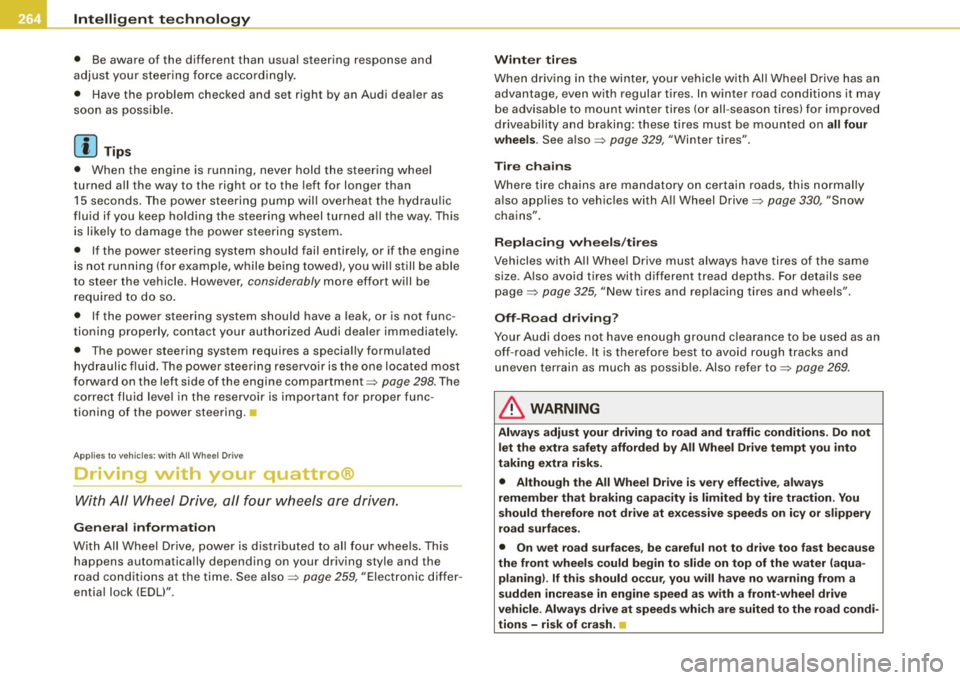
___ ln_ t _e_ ll-'"ig ...,_ e_ n_t _t_ e_ c_ h _ n_o _ l_o _,.g= y,_ __________________________________________ _
• Be aware of the different than usual steering response and
adj ust you r steer ing for ce accordingly.
• Have the problem checked and set right by an Audi dealer as
s o on as possible .
[ i ] Tip s
• When th e engine is running, never hold the steering whee l
turned all the way to the right or to the left for longer than 15 seconds. The power steering pump will overheat the hydrau lic
fluid if you keep ho lding the steering wheel turned all the way. This
is like ly to damage the power steering system.
• If the power steering system should fail entirely, or if the engine
is not running (for example, while being towed), you wil l still be able
to steer the vehicle . However,
considerably more effort will be
required to do so.
• If the power steering system should have a leak, or is not func
tioni ng properly, contact your authorized Audi dealer immediately.
• The power steering system requires a specially formulated
hydraulic fluid . The power steering reservoir is the one located most
forward on the left side of the engine compartment~
page 298. The
correct fluid level in the reservoir is important for proper func
tioning of the power steering.
App lies to vehic les: with A ll Wheel Dr ive
Dr iving with your quattro®
With All Wheel Drive, all four wheels are driven.
Gen era l i nfo rm ati on
With All Wheel Drive, power is d istr ibuted to all four whee ls. Th is
happens automatica lly depending on your driving style and the
road conditions at the time. See also ~
page 259, "Electronic differ
entia l lock (EDU".
Wint er tir es
When driving in the winte r, your vehicle with All Wheel Drive has an
advantage, even with regular tires. In winter road conditions it may
be advisable to mount winter tires (or all -season tires) for improved
driveability and braking: these tires must be mounted on
a ll fou r
wh eel s.
See also ~ page 329, "Winter tires".
Tire chains
Where tire chains are mandatory on certain roads, this normally
a lso app lies to veh icles with A ll Wheel Drive~
page 330, "Snow
chains".
R epl acing w hee ls/t ires
Vehicles with All Wheel Drive must always have tires of the same
size. Also avoid tires with different tread depths . For details see
page ~
page 325, "New tires and replacing tires and wheels" .
Off-R oa d dri ving?
Your Audi does no t have enough ground c learance to be used as an
off -road vehic le. It is therefore best to avoid rough tracks and
uneven terrain as much as possible . Also refer to~
page 269.
& WARNING
Always a djust yo ur driving to r oad and traffi c condition s. Do not
let the e xtr a s afet y affor ded b y All Whee l Dri ve tempt you into
taking extr a risks.
• Although the All Wheel Dr ive i s very effe ct ive , a lwa ys
r e member that braking capacity i s limited b y tire trac tion. You
s hould therefore not d riv e at e xcess iv e speed s on icy or slipp ery
road surfaces .
• On we t road surf aces, be care fu l no t to d riv e t oo fas t beca use
the front whe els could b egin to slid e on top of the w ater (aqu a
planing ). If t his sho uld occ ur, you will h ave no warn ing from a
s udden incr ease in engine sp eed a s with a front -wh eel drive
v ehicl e. Alwa ys dri ve at spee d s w hic h are s uited to th e road condi
tion s - risk of cra sh.
;:i
Page 316 of 390

-~_T_ ir_e_ s_ a_ n_d _ w_ h_ e_e _l_s _________________________________________________ _
& WARNING (continued)
crashes and serious personal injuries . Have worn or damaged tires
replaced immediately.
• Tires age even if they are not being used and can fail suddenly,
especially at high speeds. Tires that are more than 6 years old can
only be used in an emergency and then with special care and at
low speed.
Glossary of tire and loading terminology
Accessory weight
means the combined weight (in excess of those standard items
which may be replaced) of automatic transmission, power steering,
power brakes, power windows, power seats, radio, and heater, to
the extent that these items are available as factory-installed equip
ment (whether installed or not).
Aspect ratio means the ratio of the height to the width of the tire in percent.
Numb ers of 55 or lower indicate a low sidewall for improved
steering response and better overall handling on dry pavement.
Bead
means the part of the tire that is made of steel wires, wrapped or reinforced by ply cords and that is shaped to fit the rim.
Bead separation means a breakdown of the bond between components in the bead.
Cord
means the strands forming the plies in the tire.
& WARNING (continued)
• Never mount used tires on your vehicle if you are not sure of
their "previous history." Old used tires may have been damaged
even though the damage cannot be seen that can lead to sudden
tire failure and loss of vehicle control.
• If you notice unusual vibration or if the vehicle pulls to one side
when driving, always stop as soon as it is safe to do so and check
the wheels and tires for damage . •
Cold tire inflation pressure
means the tire pressure recommended by the vehicle manufacturer
for a tire of a designated size that has not been driven for more than
a couple of miles (kilometers) at low speeds in the three hour period
before the tire pressure is measured or adjusted .
Curb weight means the weight of a motor vehicle with standard equipment
including the maximum capacity of fuel, oil, and coolant, air condi
tioning and additional weight of optional equipment.
Extra load tire
means a tire designed to operate at higher loads and at higher infla
tion pressures than the corresponding standard tire . Extra load tires
my be identified as "XL",
"xi", "EXTRA LOAD", or "RF" on the side
wall.
Gross Axle Weight Rating ("GAWR")
means the load-carrying capacity of a single axle system, measured
at the tire -ground interfaces .
Gross Vehicle Weight Rating ("GVWR"l
means the maximum total loaded weight of the vehicle.
Page 317 of 390
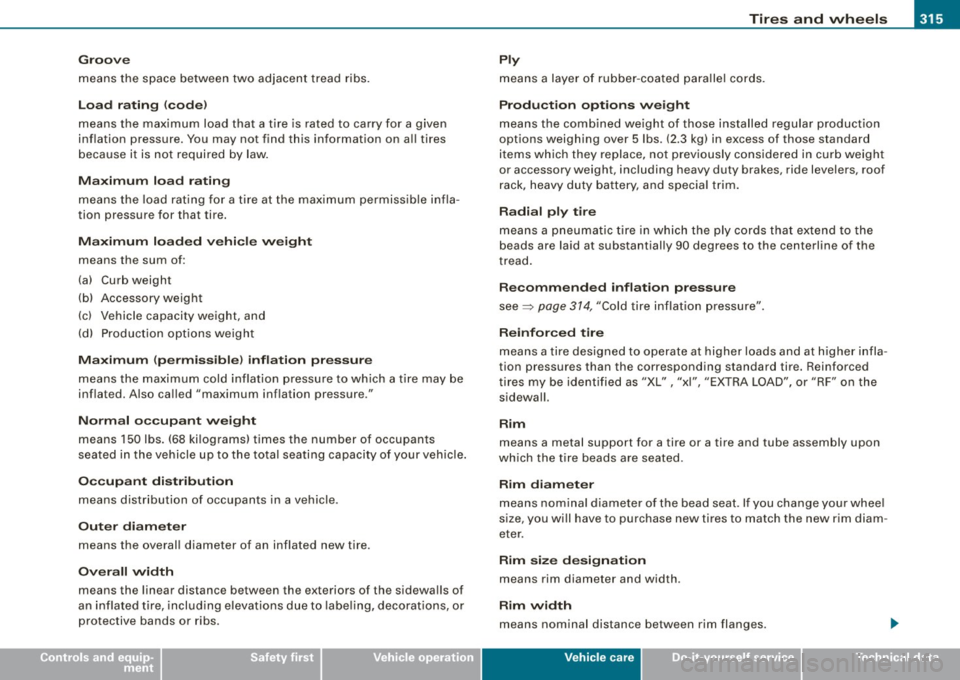
Tires a nd wh eels -
----------------
•
Groove
means the space between two adjacent tread ribs.
Load ra ting (code)
means the maximum load that a tire is rated to carry for a given
inflation pressure. You may not find this information on all tires
because it is not required by law.
M ax im um l oad ra tin g
means the load rating for a tire at the maximum permissib le infla
tion pressure for that tire.
Ma ximum l oaded v ehi cle weigh t
means the sum of:
(a) Curb weight
(b) Accessory weight
(c) Vehic le capacity weight, and
(ct) Production options weight
M ax im um (p er mi ssibl e) infl ati on pr essur e
means the maximum cold inflation pressure to wh ich a tire may be
inflated. Also ca lled "maximum inflation pressure."
Normal occ upa nt wei ght
means 150 lbs. (68 kilograms) times the number of occupants
seated in the vehicle up to the to tal seating capacity of your vehicle.
O ccupant di stributi on
means distribution of occupants in a vehicle .
Outer di am eter
means the overall diameter of an inflated new tire.
O ve rall wi dth
means the linear distance between the exteriors of the sidewa lls of
an inflated tire, includ ing elevations due to labeling, decorations, or
protective bands or ribs.
Pl y
means a layer of rubber -coated para lle l cords.
P rodu ction opt io ns wei ght
means the combined weight of those installed regular production
options weighing over 5 lbs . (2.3 kg) in excess of those standard
i t ems wh ich they replace, not previously considered in curb weigh t
or accessory weight, including heavy duty brakes, ride levelers, roof
rack, heavy duty battery, and specia l trim .
Radi al p ly tire
means a pneumatic tire in which the ply cords that extend to the
beads are laid at substantially 90 degrees to the centerline of the
tread .
Reco mm ended infl ati on pr essu re
see => page 314, "Cold tire inflation pressure".
Rein force d tir e
means a tire designed to operate at higher loads and at higher infla
tion pressures than the corresponding standard tire. Reinforced
t ires my be identified as "XL", "xi", "EXTRA LOAD", or "RF" on the
sidewall.
R im
means a metal support for a tire or a tire and tube assembly upon
wh ich the t ire beads are seated.
Rim di amet er
means nominal diameter of the bead seat. If you change your whee l
size, you wi ll have to purchase new tires to match the new rim diam
eter .
Rim siz e de sig nation
means rim diameter and width.
Rim wid th
means nominal distance between rim flanges.
Vehicle care I t •
Page 319 of 390
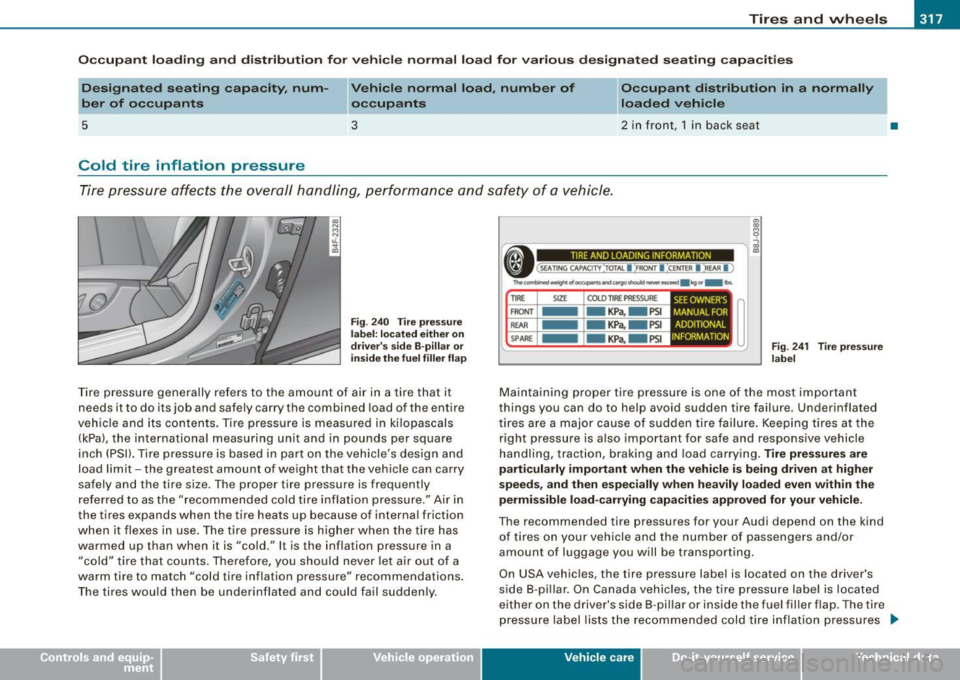
Tires and wheels -_______________ _____.
Occ up ant loading and di stribution fo r vehicle no rmal load for various d esignated seating capa cities
Designated seating capacity, num
ber of occupants Vehicle normal load
, numb er of
occupants Occupant distribution in a normally
load
ed vehicle
5 3 2 in front,
1 in bac k seat •
Cold tire inflation pressure
Tire pressure affects the overall handling, performa nce and safe ty of a vehicle .
Fig. 2 40 Tire pre ssure
label: located either on
driver' s side B -pill ar or
in sid e the fuel filler flap
Ti re pressure ge nerally refe rs to the am ount of air in a tire tha t it
needs it to do its job and safely carry the combined load of the entire
veh icle and i ts contents. Tire pressu re is measured in kilopascals
(kPa ), the internationa l measuring uni t and in pounds per square
i nc h (PSI) . Tir e p ressu re is based in par t on the vehic le's design and
load l im it - the g reatest amoun t of wei ght that the vehic le ca n carry
safe ly and the tire size . The proper tire pressure is frequently
re ferr ed to as the "recommended cold t ire i nflation pressu re ." Air i n
the tires expands when the tire heats up because of internal friction
whe n it flexes i n use . The tire pres sure is h ig her whe n the tire has
wa rmed up than when it is "co ld." It is the inflation pressure in a
"c old" tire t hat co unts. The ref ore, y ou sho uld neve r let air out of a
warm tire to match "co ld tire inflation pressure" recommendations .
T he tires wo uld then be under inflated a nd cou ld fa il s ud den ly .
i
,,-, ~ ---------------- ixl
• (SEATING CAPAC ITY :roTAL I :FRO NT I :cENTER I :REAR I ) al
Thecombh,d""'91wclo«U,,..,.andco,-goshoulcl.......,""""' •1cg., -b.
TIRE AND LOADING INFORMATION
TIRE SIZE COLO TIRE PRESSURE
F RONT -KPa, -PSI
REAR -KPa, -PSI
SPARE -KPa, - PSI
MANUAL FOR
INFORMATION SEE OWNER'S I
ADDITIONAL
Fig . 241 Tire pr essure
label
M ain tain ing pr op er tire pressure i s one of th e m ost im portant
things you can do to help avoid sudden tire failure. Underinflated
t ires are a major cause of s udden tir e fail ure . K eeping tires at the
ri ght press ure is also impor tant for sa fe and r esponsive v ehicle
han dling, trac tion, b raki ng a nd l oad carryi ng .
Tire pressures are
particularly important when the vehicle is being driven at higher
speeds , and then especially when heavily loaded even within the
permissible load -carrying capacities approved for your vehicle.
T he recommended tire pressures for your Audi depend on the kind
of tires on your vehicle a nd the n umber of passengers an d/o r
amount of luggage you w ill be transporting.
On USA vehic les, the tire pressure label is located on the driver's
s id e B- pilla r. On Cana da v ehic les, the tire pressu re labe l is loca ted
either on the driver's side 8 -pillar or inside the fuel filler flap. The tire
pre ssure label lists the rec omm ended cold tire i nflatio n pre ssures _,,,
Vehic le care I I irechnical data
Page 320 of 390
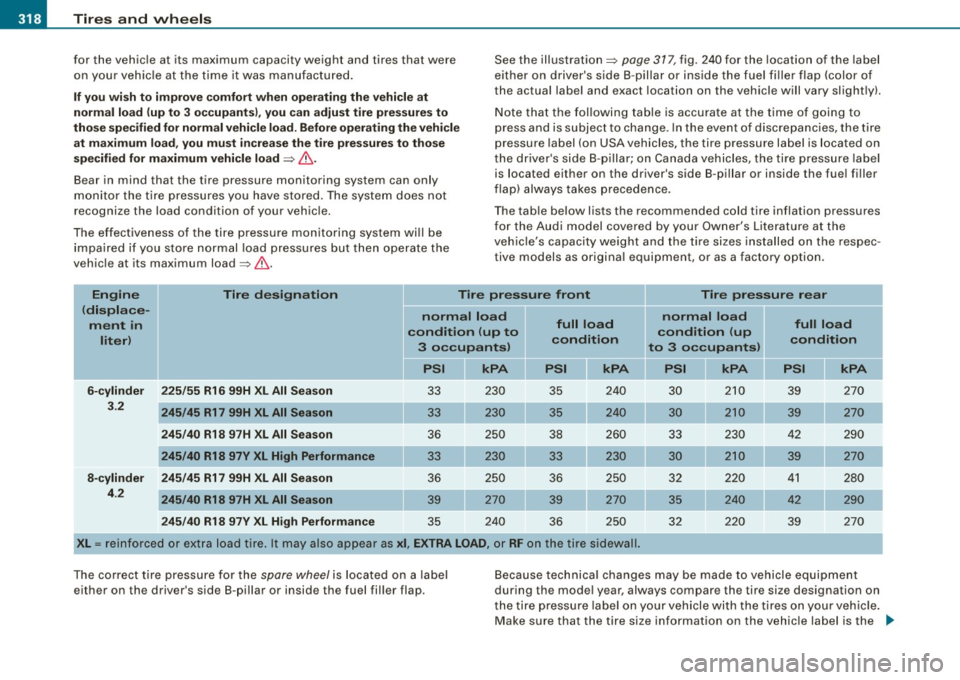
-~_T_ ir_e_ s_ a_ n_d _ w_ h_ e_e _l_s _________________________________________________ _
for the vehicle at its maximum capacity weight and tires that were
on your vehic le at the time it was manufactured.
If you w is h t o improve co mfort w hen opera ting the vehicle a t
n ormal lo ad (up t o 3 o ccupant s), you can a djust ti re pre ss ure s to
tho se s pecified for norm al v ehi cle load . B efore operating the vehi cle
at m aximum lo ad , y ou must i ncreas e the t ire p re ss ure s to tho se
s pe cifi ed for m axim um vehicle lo ad
=> & .
Bear in mind that the tire pressure monitoring system can only
monitor the tire pressures you have stored. The system does not
recognize the load condition of your vehic le.
The effectiveness of the tire pressure monitoring system will be impaired if you store normal load pressures but then operate the
vehic le at its maximum load=>&. See the
illustration=>
page 317, fig. 240 for the location of the label
either on driver's side B -p illar or inside the fuel fi ller flap (color of
the actual label and exact location on the vehicle will vary slight ly).
Note that the fol lowing tab le is accurate at the time of going to
press and is subject to change . In the event of discrepanc ies, the tire
pressure label (on USA vehicles, the tire pressure label is located on
the dr iver's side B-pi llar; on Canada vehicles, the tire pressure labe l
is located either on the driver's side B-pillar or inside the fue l fi ller
fl ap) always takes precedence.
T he table below lists the recommended cold tire inflation pressures
for the Audi model covered by your Owner's Literature at the
vehic le's capacity weight and the tire sizes installed on the respec
tive models as origina l equipment, or as a factory option.
En gin e Tire des ig nation Tir e pr essur e fro nt Tir e p re ssur e rea r
( di spl ac e-
no rm al l oa d no rm al l oa d
m ent in
conditi on (up t o full lo
ad
condition (u p full lo
ad
lit er)
condition condition 3 occupants ) to 3 occ upant s)
PSI kPA kPA kPA
6-cylinder 225/5 5 R16 99H XL All Sea son 33 230 35 240
30 210
39 270
3.2
245 /45 R17 99H XL All Season 33 230 35 240 30 2 10 39 270
2 45 /40 R1 8 97 H XL All Season 36 250
38 260 33 230 42 290
245
/40 R18 97V XL Hi gh Performan ce 33 230 33 230 30 210
39 270
8
-c ylind er 245 /45 R17 99H XL All Sea son 36 250 36 250 32 220 41 280
4.2
245/40 R18 97 H XL All S eason 39 270 39 270 35 240 42 290
2
45 /40 R18 97V XL High Perf orma nce 35 240
36 250 32 220 39 270
X
L = reinforced or extra load t ire . It may also appea r as xi, EX TRA LOAD , or RF on the tire sidewall.
The correct t ire pressure for the
spare wheel is located on a label
either on the driver's side B-pillar or inside the fuel fil ler flap. Because technica
l changes may be made to vehicle equipment
during the mode l year, always compare the tire size designation on
the tire pressure label on your vehicle with the tires on your vehic le .
Make sure that the tire size information on the vehic le label is the _.,
Page 321 of 390
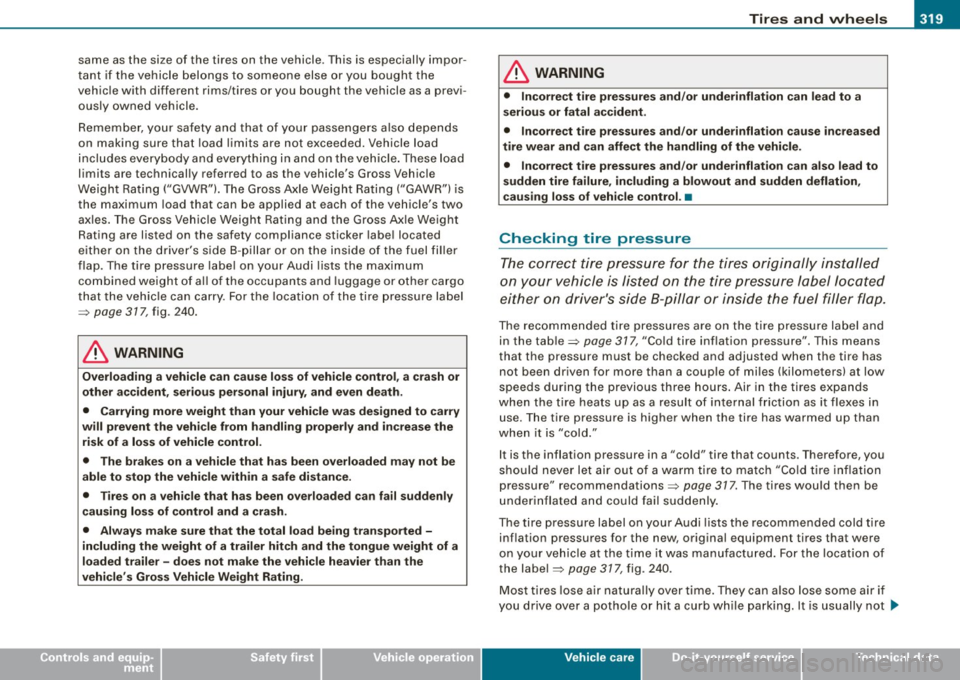
________________________________________________ T_ i _r_e _s_ a_n_ d_ w_ h_ e_e _ l_s __ lftlll
•
same as the size of the tires on the vehicle. This is especially impor
tant if the vehicle belongs to someone else or you bought the
vehicle with different rims/tires or you bought the vehicle as a previ
ously owned vehicle.
Remember, your safety and that of your passengers also depends
on making sure that load limits are not exceeded. Vehicle load
includes everybody and everything in and on the vehicle . These load
limits are technical ly referred to as the vehicle's Gross Vehicle
Weight Rating ("GVWR"l. The Gross Axle Weight Rating ("GAWR") is
the maximum load that can be applied at each of the vehicle's two
axles . The Gross Vehicle Weight Rating and the Gross Axle Weight
Rating are listed on the safety compliance sticker labe l located
either on the driver's side 8 -pillar or on the inside of the fuel fi ller
flap. The tire pressure labe l on your Audi lists the maximum
combined weight of a ll of the occupants and luggage or other cargo
that the vehic le can carry. For the location of the tire pressure label
~ page 317, fig . 240.
& WARNING
O verlo ading a vehicle can c ause los s of vehicle control , a crash or
o ther a ccident , seriou s pe rsonal inju ry, and e ven d eath .
• Carrying more weight than your v ehi cle wa s des igned to carr y
w ill p re v ent the veh icle fr om handli ng properly and in crea se the
ri sk of a lo ss of ve hicle control .
• The br ake s on a vehicle that h as been o verloa ded m ay not be
able to stop the veh icle with in a safe di sta nce .
• Tir es o n a veh icle th at ha s bee n ov erlo aded can fail sudd enl y
c au sin g loss of cont rol a nd a cra sh.
• Always mak e sure th at the total lo ad being tr ansported -
includin g the weight of a tra iler hit ch an d th e tongue weight of a
lo aded tr ailer -doe s not m ake the vehi cle he avier tha n the
v ehicle 's Gro ss V ehicle W eigh t Rating.
& WARNING
• Incorre ct t ire pre ssu re s a nd/o r unde rinflat ion can le ad to a
seriou s or fatal a ccident.
• Incorre ct t ire pr essure s and/or u nderi nflat ion cause in creased
tire wear and can affec t th e handling of the vehicl e.
• Inco rre ct t ire pr essur es and /or underinfl atio n ca n als o lead to
s udden tire failure , including a b lowout and sudden deflation ,
ca usin g lo ss of vehi cle co ntrol. •
Checking tire pressure
The correct tire pressure for the tires originally installed
on your vehicle is listed on the tire pressure label located
either on driver's side B-pillar or inside the fuel filler flap .
The recommended tire pressures are on the tire pressure label and
in the table~ page 317, "Cold tire inflation pressure". This means
that the pressure must be checked and adjusted when the tire has
not been driven for more than a couple of mi les (kilometers) at low
speeds during the previous three hours . Air in the tires expands
when the tire heats up as a result of internal fric tion as it flexes in
use. The tire pressure is higher when the tire has warmed up than
when it is "cold ."
It is the inflation pressure in a "cold" tire that counts . Therefore, you
should never let air ou t of a warm tire to match "Co ld tire inflation
pressure" recommendations~
page 317. The tires wou ld then be
underinflated and could fa il suddenly .
The tire pressure label on your Audi lists the recommended cold tire
inflation pressures for the new, original equipment tires that were
on your vehic le at the time it was manufactu red. For the location of
the labe l~
page 317, fig . 240.
Most tires lose air natural ly over time . They can a lso lose some air if
you drive over a pothole or hit a curb while parking. It is usually not ..,
Vehicle care I t •
Page 326 of 390

--~_T_ ir_e_ s_ a_ n_d _ w_ h_ e_e _l_s _________________________________________________ _
Tire pressure
Incorrect tire pressure causes premature wear and can cause
sudden tire blow-out. For this reason, tire pressure must be checked
at least once a month~
page 319.
Driving style
Driving fast around curves, heavy acceleration and hard braking
increase tire wear.
Rotating tires for more even wear
For all four tires on your vehicle to have the same service life, we
recommend that the front and rear tires are rotated according to the
tire manufacturer's suggested tire rotation intervals. Please remember the following:
• Tire rotation intervals may differ from the vehicle service inter
vals outlined in your Maintenance and Warranty Booklet.
• The longer one tire is used in one location on the vehicle, the
more it wears at certain points; therefore, we recommend that you
follow the tire manufacturer's suggested tire rotation intervals.
• Vehicles with front-wheel drive experience more tread wear on
the front wheels compared to all-wheel drive (quattro®l .
• Please rotate tires as shown ~
page 323, fig. 243.
• Extra care must be taken when rotating direction -specific tires
~ page 344.
Wheel balancing
The wheels on new vehicles are balanced. However, various situa
tions during everyday driving can cause them to become unbal
anced, resulting in vibrations you can usually feel through the
steering wheel.
Unbalanced wheels must be rebalanced to avoid excessive wear on
steering, suspension and tires. A wheel must also be rebalanced
when a new tire is installed.
Incorrect wheel alignment
Incorrect wheel alignment can cause excessive tire wear, impairing
the safety of the vehicle. If tires show excessive wear, have the
wheel alignment checked by an authorized Audi dealer or qualified
workshop.
All Wheel Drive
Vehicles with quattro® must always have tires of the same size, construction and tread type. For details see~
page 264.
& WARNING
Sudden tire failure can lead to loss of control, a crash and serious
personal injury!
• Never drive a vehicle when the tread on any tire is worn down
to the wear indicators.
• Worn tires are a safety hazard, they do not grip well on wet
roads and increase your risk of "hydroplaning" and loss of control.
• Always keep chemicals that can cause tire damage, such as
grease, oil, gasoline and brake fluid away from tires.
• Tires age even if they are not being used and can fail suddenly,
especially at high speeds. Tires that are more than 6 years old can
only be used in an emergency and then with special care and at
lower speeds.
• Never mount used tires on your vehicle if you are not sure of
their "previous history." Old used tires may have been damaged
even though the damage cannot be seen that can lead to sudden
tire failure and loss of vehicle control. •